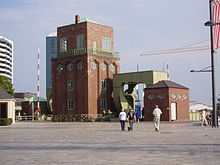New Port (Bremerhaven)
The New Harbor is a harbor basin in Bremerhaven . It is located between the city center and the Weser dike . Thanks to a modern lock , like its historical model, between the Great Lighthouse and the Zoo by the Sea , it is tide-free .
history
When increasing shipping traffic and larger ships exceeded the capacity of the old port , building officer Jacobus Johannes van Ronzelen was commissioned to plan and build a second port basin. Work began in 1847, but was interrupted due to an objection from Hanover and only continued in 1851. The New Harbor was put into operation in 1852, was 480 m long and 90 m wide. To enable the lengthening of the Lloyd steamers to be turned, the pier at the northeast end was given the characteristic bulge. The entrance was through a simple harbor gate with a passage width of 22 meters. In 1887 the gate was given a raised sliding bridge for pedestrians, who could now pass through when the gates were open. The iron halves of the gate were renewed in 1900.
The port was expanded in 1858, extended from 1860 to 1862 and widened in 1871. In 1863 Norddeutsche Lloyd built its repair workshops and in 1881 the dry dock was extended to 140 meters in length. In 1865 the kerosene sheds and kerosene lamps illuminate the quay. From 1866 on, the new "giant crane" was able to carry 45 tons. In 1875 a hand crank crane (today in the German Maritime Museum ) follows about at the level of Lloydstrasse . In 1870 the Lloydbahnhof opened its operations with the Lloydhalle at the New Harbor. In 1876, the outer harbor received the 33-meter-high Zeitball from the Deutsche Seewarte .
In 1928/29 a connection to the Kaiserhafen was established. The lock was decommissioned in 1937 and filled in in 1944 as part of the dike. The outer harbor was used by tugs .
For a short time at the beginning of the Nazi era, the ghost ship was also in the New Harbor .
Park
Until the new lock was built, there was a park-like forest on the northwest end of the outer harbor. Inside was an obelisk with four open bronze panels. They bore the names of 105 German sailors who had died in US custody during the First World War . The inscription read:
MEMORIAL STONE FOR THE GERMAN SEAVERS WHO DIED IN AMERICAN INTERNATION 1917–1919
The memorial was unveiled in front of the beach hall in September 1921 and moved to its new location in 1938.
Today's port
The historic port, from which the large emigrant ships of the North German Lloyd to America used to set off, is now intended to offer an attractive berth for sports boats , yachts and museum ships . At the same place where there was originally a lock, it received a 50-meter-long and 14-meter-wide chamber lock, which was inaugurated on July 7, 2005.
With the steam icebreaker and museum ship Wal on the Ostkai, the port today offers a maritime environment for the zoo by the sea, the German Emigration Center and restaurants. The Watten salvage tug Goliath , which was scrapped in 2011, was also lying on the east quay . On the west side of the port, in the area of the marina between the port basin and the Lohmanndeich, the remains of the former Lloyd dock have been preserved, a 150 meter long and 36 meter wide dry dock of North German Lloyd, which was designed as a twin dock.
literature
- Herbert Black Forest : The Great Bremen Lexicon . 2nd, updated, revised and expanded edition. Edition Temmen, Bremen 2003, ISBN 3-86108-693-X .
- Federal Railway Directorate Hanover: 1843–1983. 140 years of the Hanover Railway Directorate. Hanover undated (1983?). Page 29ff.
Web links
Individual evidence
- ^ Heiko Eggers: Memorial stone in the park at the old lighthouse, portal stone of the Hanover tower fort. In: Lars U. Scholl (Hrsg.): Bremerhaven - a port history guide . Deutsches Schifffahrtsmuseum / Ditzen, Bremerhaven 1980, p. 114.
Coordinates: 53 ° 32 ′ 45 ″ N , 8 ° 34 ′ 20 ″ E



